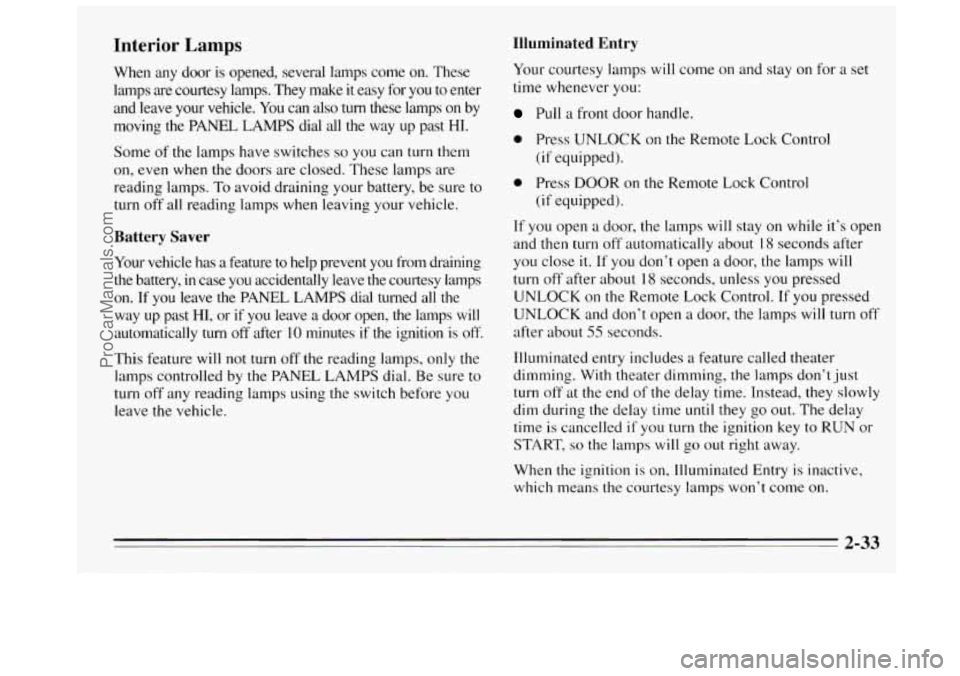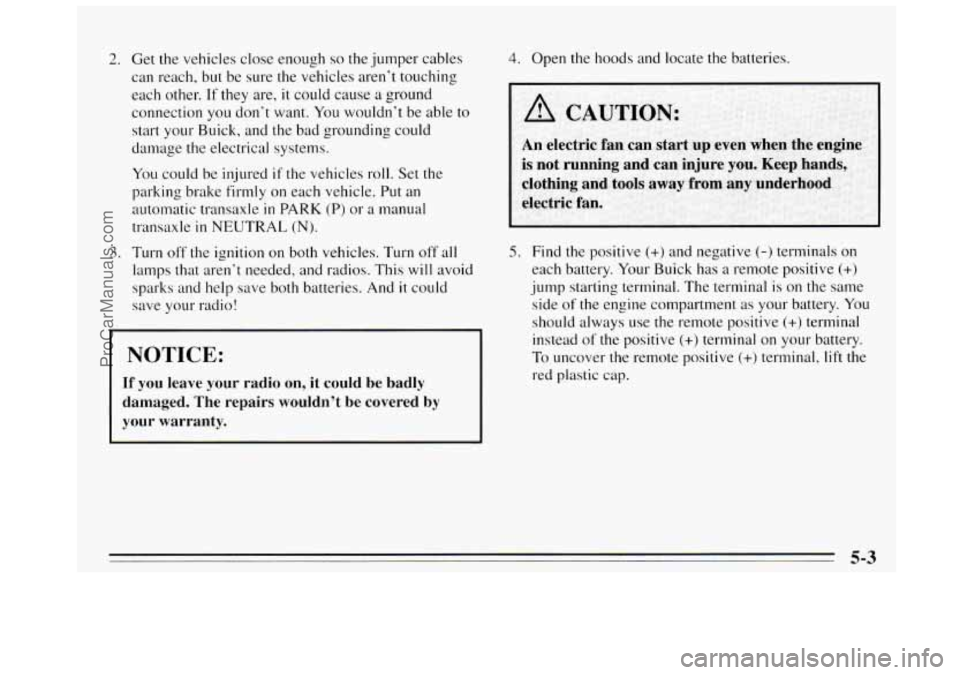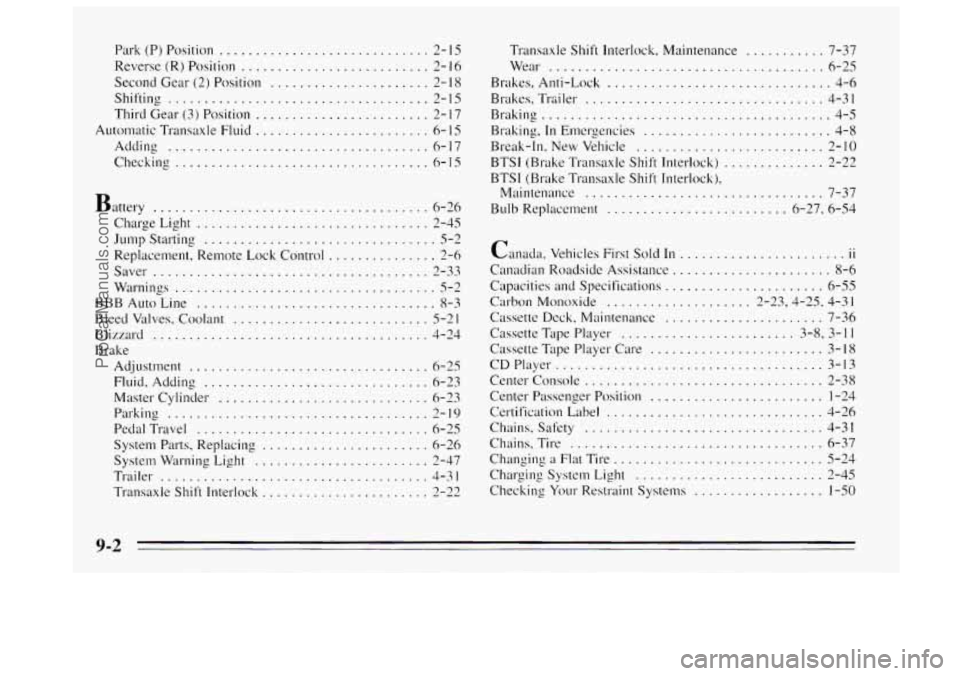1995 BUICK REGAL remote start
[x] Cancel search: remote startPage 95 of 340

Interior Lamps
When any door is opened, several lamps come on. These
lamps
are courtesy lamps. They make it easy for you to enter
and leave your
vehcle. You can also turn these lamps on by
moving the PANEL LAMPS dial all the way up past
HI.
Some of the lamps have switches so you can turn them
on, even when the doors are closed. These lamps are
reading lamps.
To avoid draining your battery, be sure to
turn
off all reading lamps when leaving your vehicle.
Illuminated Entry
Battery Saver
Your vehicle has a feature to help prevent you from draining
the battery, in case you accidentally leave the courtesy lamps
on. If you leave the PANEL LAMPS dial turned all the
way up past
HI, or if you leave a door open, the lamps will
automatically
turn off after 10 minutes if the ignition is off.
This feature will not turn off the reading lamps, only the
lamps controlled by
the PANEL LAMPS dial. Be sure to
turn off any reading lamps using the switch before you
leave the vehicle. Your
courtesy lamps will come on and stay on for
a set
time whenever you:
Pull a front door handle.
0 Press UNLOCK on the Remote Lock Control
(if equipped).
0 Press DOOR on the Remote Lock Control
(if equipped).
If you open
a door, the lamps will stay on while it’s open
and then turn off automatically about 18 seconds after
you close it. If you don’t open a door,
the lamps will
turn off after about 18 seconds, unless you pressed
UNLOCK
on the Remote Lock Control. If you pressed
UNLOCK and don’t open
a door, the lamps will turn off
after about 55 seconds.
Illuminated entry includes a feature called theater
dimming. With theater dimming,
the lamps don’t just
turn off at the end of the delay time. Instead, they slowly
dim during the delay time
until they go out. The delay
time
is cancelled if you turn the ignition key to RUN or
START,
so the lamps will go out right away.
When the ignition is on, Illuminated Entry is inactive,
which means the courtesy lamps won’t come on.
ProCarManuals.com
Page 177 of 340

2. Get the vehicles close enough so the jumper cables
can reach,
but be sure the vehicles aren’t touching
each other.
If they are, it could cause a ground
connection
you don’t want. You wouldn’t be able to
start your Buick, and the bad grounding could
damage the electrical systems.
You could be injured
if the vehicles roll. Set the
parking brake firmly on each vehicle. Put an
automatic transaxle
in PARK (P) or a manual
transaxle
in NEUTRAL (N).
3. Turn off the ignition on both vehicles. Turn off all
iamps that aren’t needed, and radios. This will avoid
sparks and help save both batteries. And
it could
save your radio!
NOTICE:
If you leave your radio on, it could be badly
damaged. The repairs wouldn’t be covered
by
your warranty.
4. Open the hoods and locate the batteries.
A CAUTION:
An electric fan can start up even when the engine
is not running and can injure you. Keep hands,
clothing and tools away from any underhood
electric fan.
5. Find the positive (+) and negative (-) terminals on
each battery. Your Buick has a remote positive
(+)
jump starting terminal. The terminal is on the same
side of
the engine compartment as your battery. You
should
always use the remote positive (+) terminal
instead of the positive
(+) terminal on your battery.
To uncover the remote positive
(+) terminal, lift the
red plastic cap.
3-3
ProCarManuals.com
Page 328 of 340

Park (P) Position ............................. 2- I5
Second Gear (2) Position
...................... 2- 18
Reverse (R) Position .......................... 2- I6
Shifting .................................... 2-15
Third Gear (3) Position
........................ 2- I7
Automatic Transaxle Fluid ........................ 6- 15
Adding
.................................... 6-17
Checking
................................... 6- 15
Battery ...................................... 6-26
Cllarpe Light
................................ 2-45
Jump Starting
................................ 5-2
Replacement. Remote Lock Control
............... 2-6
Saver
...................................... 2- 33
Warnings .................................... 5-2
BBB Auto Line ................................. 8-3
Bleed Valves. Coolant
........................... 5-21
Blizzard ...................................... 4-24
Brake
Adjustment
................................. 6-25
Fluid. Adding
............................... 6-23
Master Cylinder
............................. 6-23
Parking
.................................... 2-19
PedalTravel ................................ 6-25
System Parts. Replacing ....................... 6-26
System Warning Light
........................ 2-47
Trailer
..................................... 4- 31
Transaxle Shift Interlock ....................... 2-22 Transaxle Shift Interlock
. Maintenance ........... 7-37
Wear
...................................... 6-25
Brakes. Anti-Lock
............................... 4-6
Brakes. Trailer .................................
Braking . In Emcrgencies .......................... 4-8
Break-In. New Vehicle .......................... 2-10
BTSI (Brake Transaxle Shift Interlock)
.............. 2-22
Maintenance
................................. 7-37
Bulb Replacen~ent ......................... 6-27. 6-54
Braking
........................................ 4-5
BTSI
(Brake Transaxle Shift Interlock).
Canada. Vehicles First Sold In 11
Canadian Roadside Assistance ...................... 8-6
Capacities and Specit'ications
...................... 6-55
Carbon Monoxide
.................... 2-23. 4-25. 4-31
Cassette Dcck. Maintenance ...................... 7-36
Cassette
Tape Player ........................ 3-8. 3-11
Casselte Tape Player Care
........................ 3-18
CDPlaye r
..................................... 3-13
Center Console
................................. 2-38
Center Passenger Position
........................ 1-24
Certification Label .............................. 4-26
Chains. Safety
................................. 4-31
Chains. Tire
................................... 6-37
Changing
a Flat Tire ............................. 5-24
Charging System Light
.......................... 2-45
Checking Your Restraint Systems .................. 1-50
.. .......................
9-2
ProCarManuals.com